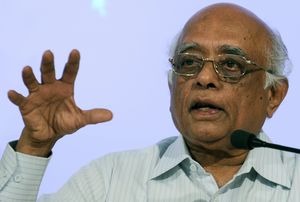The best thing about Rajagopala Chidambaram, who passed away recently, was that he “could keep his mouth shut”, as his mentor Raja Ramanna wrote in his memoir, Years of Pilgrimage. No wonder, he tested six atom bombs with no CIA, ISI or satellite spy eyes getting any wiser beforehand.
Six bombs? Didn’t he preside over only five tests in 1998? Yes, but he had been the key man behind the 1974 test.
Was that a bomb, or a peaceful nuclear explosion? There is no difference, wrote Chidambaram in his memoir India Rising: “The physics is the same... only the packaging is different.” He should know; he had worked on the physics of the 1974 test.
Ramanna, considered the father of the Indian bomb (no disrespect to Homi Bhabha, who was ready to test in 1965, but Lal Bahadur Shastri didn’t agree), had recruited the shy youth with a doctorate in physics, and asked him to work on the ‘peaceful’ bomb while pretending to continue his work on crystallography. Chidambaram worked on both. He talked a lot about crystallography, but kept his mouth shut about the bomb work.
Probably, he trusted no one. So much so, he travelled all the way from Bhabha Atomic Research Centre in Mumbai to Pokhran on the back of an Army truck, sleeping atop the trunk that carried the plutonium for the test.
A fortnight before the Buddha was to smile, Ramanna drove into the sands and asked his second-in-command P.K. Iyengar if everything was in place. "This has to work,” said Iyengar, “or the laws of physics are wrong.”
As Chidambaram had planned, the laws of physics worked on May 18, 1974, announcing the arrival of a sixth horseman into the world of atom elite. Atomic folklore has it that he coined the coded cable “Buddha is smiling”, that informed Indira Gandhi of the test success.
As India’s atomic head a score and four years later, he would get five more devices tested for A.B. Vajpayee. He, along with Defence Research and Development Organisation head V.S.R. Arunachalam, and later A.P.J. Abdul Kalam, whose job was to marry the bombs made by the atomic scientists to his missiles, had been briefing all the prime ministers. Finally, Vajpayee gave the go-ahead.
There was an urgency about the 1998 test. After they found out and forced P.V. Narasimha Rao to cancel his test, the atom-armed big five had been making life miserable for poor H.D. Deve Gowda and I.K. Gujral, flashing a treaty that would bound every country not to test ever—underground, overground or anywhere. It was now or never—Chidambaram and team impressed upon Vajpayee. That was like preaching to the converted.
But once he got the green signal, Chidambaram gave a yellow signal. Not immediately, sir, he told Vajpayee; only after you win the confidence vote in Parliament. Vajpayee smiled like a Buddha. The Buddha smiled again, five times, on May 11 and 13, 1998.
The statesman in Chidambaram emerged after the tests. To mollify world opinion, especially the sanctions-obsessed US, Vajpayee declared a moratorium on further tests. The scientific community, who wanted more bangs to weaponise new models, was outraged. It was left to Chidambaram to do a quiet fire-fighting for the government, impressing on the scientists that they couldn’t have everything their way. The elected government had the final say.
The bomb-maker was a talent-hunter, too. Later, as principal scientific adviser to Vajpayee, Manmohan Singh and Narendra Modi, he impressed upon them the importance of attracting techno-fascinated small town boys and girls to pure sciences. As he once said, "My best scientists in BARC did not come from the IITs but from Kolhapur and Coimbatore."
prasannan@theweek.in


